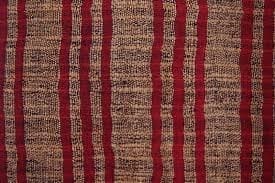Bali is a province of Indonesia and the westernmost of the Lesser Sunda Islands. West of Lombok and east of Java, the province includes the island of Bali and few other neighbouring islands. Denpasar, the provincial city, is the most populous city in the Lesser Sunda Islands and the second largest in Eastern Indonesia.
Bali is the only Hindu- majority province in Indonesia, with 82.5% of the population adhering to Balinese Hinduism. Bali is Indonesia’s main tourist destination, with a significant growth in tourism since the 1980’s. Bali is part of the Coral Triangle, the area with the highest biodiversity of marine species especially fish and turtles. In this area alone, over 500 reef-building coral species can be found.
Dialect
Indonesian and Balinese are the most widely spoken languages in Bali. The vast majority of Balinese people are bilingual or trilingual. The most common spoken language around the tourist areas is Indonesian. As many people in the tourist sector are not only Balinese, but migrants from Java, Lombok, Sumatra and other parts of Indonesia.
The use of different Balinese languages was traditionally determined by the Balinese caste system and clan membership. But this tradition is diminishing. Sanskrit and Kawi are also commonly used by some Hindu priests in Bali. As Hindu literature was mostly written in Sanskrit.
Chinese and English are other most common languages of many Balinese. This owes to the requirements of the tourism industry. Also, English- speaking community and huge Chinese- Indonesian population. Other foreign languages, such as Korean, Russian, French, Japanese or German. These are often used in multilingual signs for foreign tourists.
Tradition

Dancer, Bali,2007
Bali is famous for its diverse and sophisticated art forms. This includes painting, sculpture, handcrafts, woodcarving, and performing arts. Balinese impactful orchestra music, known as gamelan is highly varied and developed. Balinese cuisine is also unique. Balinese performing arts portray stories from Hindu epics such as the Ramayana but with heavy Balinese influence.
Bali boasts one of the most diverse and innovative performing arts cultures in the world. They have paid performances at thousands of private ceremonies, temple festivals, or public shows. Balinese dances include baris, legong, barong, topeng, pendet, gong keybar, and kecak.
Festivals
There are many festivals celebrated locally or island-wise according to the traditional calendars, throughout the year. Nyepi, the Hindu New Year is celebrated in the spring by a day of silence. On this day everyone stays at home and tourists are motivated to remain in their hotels. On the day before New Year, large and colourful sculptures of Ogoh-ogoh monsters are paraded. And burned in the evening to drive away evil spirits.
Other festivals throughout the year are specifies by the Balinese pawukon calendrical system. Celebrations are held for occasions such as tooth- filing, odalan or cremation. One most important concept that Balinese ceremonies have in common is that of désa kala patra. It refers to how ritual performances must be appropriate in both the specific and general social context. Many celebrations call for a loud, boisterous atmosphere with much activity. And the resulting aesthetic, ramé, is distinctively Balinese.
Often two or more gamelan ensembles will be performing well within earshot, and sometimes compete with each other to be heard. Buildings such as temples and residential homes are spatially oriented by having the most sacred spaces closest to the mountain and the unclean places nearest to the sea.
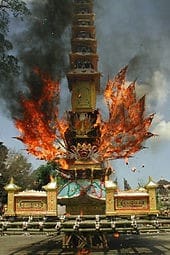
Cremation in Ubud
Balinese textiles
Balinese textiles are reflective of the historical traditions of Bali. Bali has been historically linked to the major courts of Java before the 10th century. Following the defeat of the Majapahit kingdom, many of the Javanese aristocracy fled to Bali. The traditions were continued. Bali thus may be seen as a repository not only of its own arts but those of Java in the pre-Islamic 15th century.
The use of textile is a living tradition and so is in constant change. It will also vary from one district to another. Any attempt to definitively describe Balinese textiles and their use is doomed to be incomplete. For the most part old cloth is not venerated for their age. New is much better. In the tropics cloth rapidly deteriorates and so virtue is generated by replacing them.
Textile as symbol
In Bali, textiles are much more than just cloths from which garments are made. Beginning with the yarn and the woven cloth. They are a medium through which the divine nature of the universe and its material manifestations are recognized and expressed. Cloth is central to all Balinese spiritual activities.
In every Balinese Hindu household, every day a family member will make offerings to the gods. To do this she must minimally wear a sash around her waist. Trees and important rocks are wrapped in the black and white poleng. The men of the village banjar wears a sarong and sash when they gather for a working bee in the temple. The more important the event, the more formal and complex is the dress.
Poleng

A baris polèng dancers, Kuta 2009
Polèng cloth are black and white checkered pattern seen nearly everywhere. Polèng refers to the black and white squares. It does not refer to the material from which it is made or if it is woven or printed. Java produces most of the printed cloth. But there are still weavers in Bali who produce hand woven polèng for special applications. A frequent use of Polèng is as a wrapper for sacred trees, rocks, and shrines.
Endek
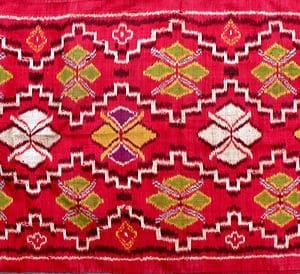
Old silk endek from Singaraja, early 20thC (tumpak bela design)
The patterning technique of making this is ikat of the weft. Endek was woven as individual pieces on a backstrap loom once solely for high caste Balinese families. But now it is produced in large quantities by the yard in workshops. These workshops are done in Tabanan, Gianyar, Denpasar and other places on unmechanized looms.
The earliest extant endek comes from the North Balinese Kingdom of Buleleng. It is dated back from the late 19th century. And these are majorly of geometric designs. The colour of these early cloths is red. These usually had songket ends. Later on, yellows and green were used and the songket was omitted.

Modern ikat of the warp creating a geringsing pattern

Early Singaraja silk endek
Bebali
Bebali is the name usually ascribed to a small group of textiles that appear to have been completely sacred in function. The weave is broadly spaced giving the textile a delicate gauze like quality. Hauser-Schaubilin states that there are at least nine differently patterned bebali cloths, each with its own name. There is, for example-
- Cloth with a white warp and weft broken by green, yellow and red stripes known as cenana kawi. This is worn in function of 3-month ritual and also are laid out in the central shrine of an ancestral temple.
- Enkakan taluh has a vivid red-and white checked pattern. It is brought to the temple as an apparel for Brahma, the god residing in the south.
- Bias membah has a white warp and weft in which grey and white stripes alternate.
Two examples of bebali cloth are:
- Firstly, flat cloth, like Kain cepuk, Kain Songket, Kain Sekordi.
- Secondly round cloth, where the cloth is removed from the loom and the threads not cut leaving a seamless cloth sheet.
In the north and south of Bali known as Kain Wangsul which means “to go round” or “to return”. In the east of Bali, especially Klungkung and Karangasem, they are called Gedogan or “circle”, the circle represents zero. These bebali cloths are now being made with natural dyes. And manufactured cottons in the traditional manner with a quality that is comparable with the earlier collected pieces of the 1920s.
Keling
Keling are traditionally woven cloths in stripes of red, yellow, dark blue or black. These are made from hand spun cotton dyed with natural dyes. Theses dyes are obtained from the roots of the sunti for red colour, and fruit of kunti for yellow colour.
In earlier times most of the women of Nusa Penida wore keling underskirts described by Claire Holt in the 1930s. She described multi-coloured striped cloth worn under the dark blue upper Kain in such a way that only a small part showed. The name comes from the Balinese word keeling which refers to Indian merchant.
The roots may be related to an older legend concerning the primal ancestors of the village Tenganan. They are king Kaung and his wife Keling. This is backed by the observation that the cloths are traditionally worn by women. Ritual uses of keling include in the otonin 6-month ceremony for a child. These ceremonies are held to keep away evil spirits and in other rites of passage.
Geringsing
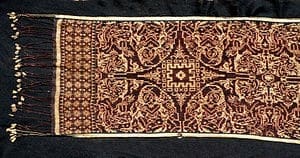
Geringsing Wyang Putri
Geringsing is the double ikat that is woven in the village of Tenganan Pegringsinga. Around 20 patterns of geringsing are known. The dimensions of the cloths range from 20 cm to 60 cm wide and can be over 2 meter long. The palette of geringsing is typically red, neutral, and black.
The first European to describe geringseng was W.O.J.Nieuwenkamp; he discovered where they came from and made a journey to Tenganan. Geringsing are regarded as sacred cloths, “ascribed supernatural properties, especially to assist in forms of healing, including exorcism.” It is mentioned in the poem Rangga Lawe which tells of the first Majapahit king, Raden Wijaya giving his warriors gerinsing sashes to protect them in Battle.
The weaving technique is the dying of the thread is complex and ritualized. Once dyed, the warp is laid out on the loom and the cloth is woven in a loose balanced weave. The pattern is carried by both the warp and the weft. Great precision is needed at all stages of the production. Using a pick, the weaver adjusts the weft with each pass of the shuttle to make sure the alignment of the pattern is precise.
Prada
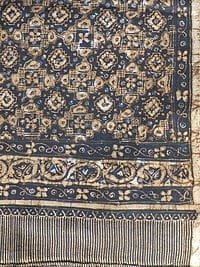
Old prada, Kain Panjang
In Bali, prada (also called as perada) is the name given to the technique of decorating a cloth with gold dust or gold leaf. Prada is not exclusively a Balinese textile. Old Javanese sources suggest that it was popular in the aristocratic circles of the East Javanese kingdom of Majapahit.
Prada is now used in almost every ceremonial function. It is used to decorate ceremonial umbrellas for processions, it wraps temples, decorates the penjor ceremonial flags, is used in dancer’s costumes and almost anywhere that some glitter is required.
Batik from Java was once commonly the base material. But now a brightly coloured commercial cloth is usually used. In the past a whitish glue (ancur) obtained from fish bones, or a darker glue made from water buffalo skin was applied and the gold then applied. Real gold prada is almost never seen today. It has been replaced by cloth printed with a gold paint or a plastic foil.
Songket

Silk singaraja songket sarong
Songkèt is the technique in which a supplementary weave of the weft is used to create the pattern. The early songkèt were entirely of silk with a supplementary weft of gold thread. Today mixed cloths are seen with cotton, gimp golden and silver threads, viscose and artificial silk. Originally the preserve of the highest castes, with the democratization of Balinese society anyone who can afford to buy them is now able to do so.
Thus, songkèt has become an integral part of the ceremonial wardrobe of well-to-do Balinese. Both men and women wear full-body songket wraps for some of life’s most important moments. At a Balinese wedding, the bride and groom wear a pair of matching songket. The Balinese also wear songket when their teeth are filed in a ceremony called metatah.

Detail of songket sarong. woven on a narrow back-starp loom and then joined
Lamak

Lamek, Tropen museum
Lamek are long banners that are hung from penjor, at the festival of galungan. Hung in front of temples and shrines at other important festivals. The design of lamak generally has a stylized ‘cili’ figure at the top. It is represented by a triangular skirt, followed by a long-pattered field, ending in a row of tumpal the cili is often associated with Dewi Sri, the deity of fertility and prosperity. Despite her feminine form the figure should be understood as a symbol of both men and women.
In most cases they are made from cross cut and applied palm leaf. Therefore, are quite perishable. Only occasionally they are made from cotton woven in a supplementary weave. In the western and northern parts of Bali, lamak are made of cloth. All textile techniques can be found from weaving, embroidery and appliqué.
Ider- ider
Ider-ider are a length of cloth onto which a story has been embroidered. Often from Ramayana or Mahabharata. These are used as a valance for a temple or a balé. All forms of textile techniques can be used including chain stitching, applique, sequins.
Cepuk
From the island of Nusa Penida, Kamben cepuk is an ikat of the weft. These textiles were used as special ceremonial clothing in the past. Now more commonly serve as temple decoration.
Article by- Sneha Savla




